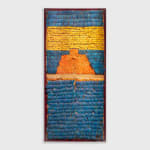Huari Culture 100 AD-1200 AD
35'4" x 70'8" in.
Feathers are a rare and valued commodity imported from the Amazonian basin. The journey in those times to collect the bundles from the forest tribes was not only arduous but also perilous. Such feathers being a great luxury were only worn by the dignitaries, priests, and warlords as symbols of status and power.
From an aesthetic point of View, Andean feathers works speak more eloquently for themselves than a thousand words. It should, however, be pointed out that their sacredness was not a function of their rarity but rather, by association with the Celestial messenger, the Condor —Eagle, the wearer shared the supernatural powers of this divine intercessor, guide of the souls to the mystical realm of light.







